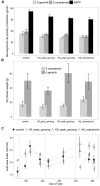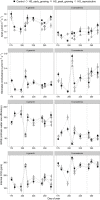Timing Effects of Heat-Stress on Plant Ecophysiological Characteristics and Growth
- PMID: 27853463
- PMCID: PMC5090777
- DOI: 10.3389/fpls.2016.01629
Timing Effects of Heat-Stress on Plant Ecophysiological Characteristics and Growth
Abstract
Heat-waves with higher intensity and frequency and longer durations are expected in the future due to global warming, which could have dramatic impacts in agriculture, economy and ecology. This field study examined how plant responded to heat-stress (HS) treatment at different timing in naturally occurring vegetation. HS treatment (5 days at 40.5°C) were applied to 12 1 m2 plots in restored prairie vegetation dominated by a warm-season C4 grass, Andropogon gerardii, and a warm-season C3 forb, Solidago canadensis, at different growing stages. During and after each heat stress (HS) treatment, temperature were monitored for air, canopy, and soil; net CO2 assimilation (Anet), quantum yield of photosystem II (ΦPSII), stomatal conductance (gs), and internal CO2 level (Ci), specific leaf area (SLA), and chlorophyll content of the dominant species were measured. One week after the last HS treatment, all plots were harvested and the biomass of above-ground tissue and flower weight of the two dominant species were determined. HS decreased physiological performance and growth for both species, with S. canadensis being affected more than A. gerardii, indicated by negative HS effect on both physiological and growth responses for S. canadensis. There were significant timing effect of HS on the two species, with greater reductions in the net photosynthetic rate and productivity occurred when HS was applied at later-growing season. The reduction in aboveground productivity in S. canadensis but not A. gerardii could have important implications for plant community structure by increasing the competitive advantage of A. gerardii in this grassland. The present experiment showed that HS, though ephemeral, may promote long-term effects on plant community structure, vegetation dynamics, biodiversity, and ecosystem functioning of terrestrial biomes when more frequent and severe HS occur in the future.
Keywords: Andropogon gerardii; Solidago canadensis; aboveground productivity; global climate change; photosynthesis.
Figures






Similar articles
-
Effects of N on plant response to heat-wave: a field study with prairie vegetation.J Integr Plant Biol. 2008 Nov;50(11):1416-25. doi: 10.1111/j.1744-7909.2008.00748.x. J Integr Plant Biol. 2008. PMID: 19017129
-
Productivity responses to altered rainfall patterns in a C4-dominated grassland.Oecologia. 2003 Oct;137(2):245-51. doi: 10.1007/s00442-003-1331-3. Epub 2003 Jul 5. Oecologia. 2003. PMID: 12845518
-
Impact of a short-term heat event on C and N relations in shoots vs. roots of the stress-tolerant C4 grass, Andropogon gerardii.J Plant Physiol. 2014 Jul 15;171(12):977-85. doi: 10.1016/j.jplph.2014.04.006. Epub 2014 Apr 24. J Plant Physiol. 2014. PMID: 24974323
-
Warming Treatment Methodology Affected the Response of Plant Ecophysiological Traits to Temperature Increases: A Quantitive Meta-Analysis.Front Plant Sci. 2019 Sep 6;10:957. doi: 10.3389/fpls.2019.00957. eCollection 2019. Front Plant Sci. 2019. PMID: 31552059 Free PMC article.
-
Achievable productivities of certain CAM plants: basis for high values compared with C3 and C4 plants.New Phytol. 1991 Oct;119(2):183-205. doi: 10.1111/j.1469-8137.1991.tb01022.x. New Phytol. 1991. PMID: 33874131 Review.
Cited by
-
CaHSP16.4, a small heat shock protein gene in pepper, is involved in heat and drought tolerance.Protoplasma. 2019 Jan;256(1):39-51. doi: 10.1007/s00709-018-1280-7. Epub 2018 Jun 26. Protoplasma. 2019. PMID: 29946904
-
The ecological consequences of the timing of extreme climate events.Ecol Evol. 2023 Jan 24;13(1):e9661. doi: 10.1002/ece3.9661. eCollection 2023 Jan. Ecol Evol. 2023. PMID: 36713483 Free PMC article.
-
Functional Characterization of Tomato Phytochrome A and B1B2 Mutants in Response to Heat Stress.Int J Mol Sci. 2022 Jan 31;23(3):1681. doi: 10.3390/ijms23031681. Int J Mol Sci. 2022. PMID: 35163602 Free PMC article.
-
Desiccation Mitigates Heat Stress in the Resurrection Fern, Pleopeltis polypodioides.Front Plant Sci. 2020 Nov 30;11:597731. doi: 10.3389/fpls.2020.597731. eCollection 2020. Front Plant Sci. 2020. PMID: 33329661 Free PMC article.
-
Eco-Physiological Screening of Different Tomato Genotypes in Response to High Temperatures: A Combined Field-to-Laboratory Approach.Plants (Basel). 2020 Apr 15;9(4):508. doi: 10.3390/plants9040508. Plants (Basel). 2020. PMID: 32326566 Free PMC article.
References
-
- Andrello M., Bizoux J. P., Barbet-Massin M., Gaudeul M., Nicole F., Till-Bottraud I. (2012). Effects of management regimes and extreme climatic events on plant population viability in Eryngium alpinum. Biol. Conserv. 147 99–106. 10.1016/j.biocon.2011.12.012 - DOI
-
- Balouchi H. (2010). Screening wheat parents of mapping population for heat and drought tolerance, detection of wheat genetic variation. Int. J. Biol. Life Sci. 6 56–66.
LinkOut - more resources
Full Text Sources
Other Literature Sources
Miscellaneous

